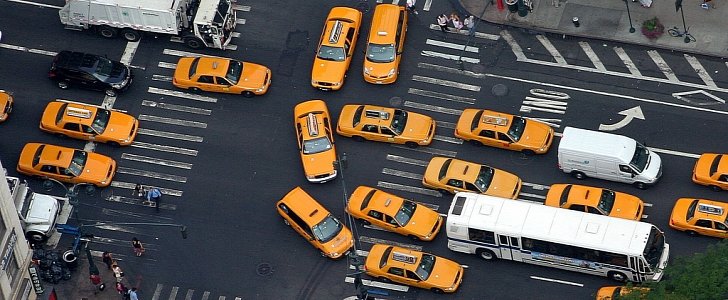If you've ever seen a picture of downtown New York, probably half of it featured one particular color: yellow. That's because the famous cabs are a very familiar sight among the heavy traffic specific to one of the busiest cities in the world.
The Big Apple may offer other transportation options, but some people would rather be shot dead than be seen taking the train, so it's fair to assume the taxi drivers have no reason to fear for their jobs.
Well, not if the mayor of the city turns an ear to what the MIT has to say. The renowned Massachusetts Institute of Technology used algorithms and other fancy stuff we should have paid attention during maths class to understand to analyze data from over three million taxi rides.
Then, based on its findings, it wanted to see what benefits would the use of ride-sharing vehicles bring in terms of time and congestion. The intricate system calculated that a fleet of 3,000 cars with room for four would cover 98 percent of the current taxi demand in NYC. Using a 10-man setup, 95 percent would be covered by just 2,000 vehicles. It's worth noting that over 14,000 cabs are currently operating in New York.
“Instead of transporting people one at a time, drivers could transport two to four people at once, results in fewer trips, in less time, to make the same amount of money,” said Daniela Rus of MIT’s Computer Science and Artificial Intelligence Laboratory (CSAIL). “A system like this could allow drivers to work shorter shifts, while also creating less traffic, cleaner air and shorter, less stressful commutes.”
“To our knowledge, this is the first time that scientists have been able to experimentally quantify the trade-off between fleet size, capacity, waiting time, travel delay, and operational costs for a range of vehicles, from taxis to vans and shuttles,” continued Rus. “What’s more, the system is particularly suited to autonomous cars, since it can continuously reroute vehicles based on real-time requests.”
Carpooling with services such as Uber or Lyft wouldn't just free up traffic, it would also speed up the process by 20 percent, the study says, with an average waiting time of just 2.7 minutes.
Of course, there's just one chink in MIT's proposal's armor: do people who take taxis - or hail Uber or Lyft cars - really want to share their ride with somebody else? Further more, wouldn't a ten-man van feel a lot like a bus for some of them? Are people really so open-minded to understand that something they don't particularly like is actually better for them? Probably not. You can read more on MIT's study here.
Well, not if the mayor of the city turns an ear to what the MIT has to say. The renowned Massachusetts Institute of Technology used algorithms and other fancy stuff we should have paid attention during maths class to understand to analyze data from over three million taxi rides.
Then, based on its findings, it wanted to see what benefits would the use of ride-sharing vehicles bring in terms of time and congestion. The intricate system calculated that a fleet of 3,000 cars with room for four would cover 98 percent of the current taxi demand in NYC. Using a 10-man setup, 95 percent would be covered by just 2,000 vehicles. It's worth noting that over 14,000 cabs are currently operating in New York.
“Instead of transporting people one at a time, drivers could transport two to four people at once, results in fewer trips, in less time, to make the same amount of money,” said Daniela Rus of MIT’s Computer Science and Artificial Intelligence Laboratory (CSAIL). “A system like this could allow drivers to work shorter shifts, while also creating less traffic, cleaner air and shorter, less stressful commutes.”
“To our knowledge, this is the first time that scientists have been able to experimentally quantify the trade-off between fleet size, capacity, waiting time, travel delay, and operational costs for a range of vehicles, from taxis to vans and shuttles,” continued Rus. “What’s more, the system is particularly suited to autonomous cars, since it can continuously reroute vehicles based on real-time requests.”
Carpooling with services such as Uber or Lyft wouldn't just free up traffic, it would also speed up the process by 20 percent, the study says, with an average waiting time of just 2.7 minutes.
Of course, there's just one chink in MIT's proposal's armor: do people who take taxis - or hail Uber or Lyft cars - really want to share their ride with somebody else? Further more, wouldn't a ten-man van feel a lot like a bus for some of them? Are people really so open-minded to understand that something they don't particularly like is actually better for them? Probably not. You can read more on MIT's study here.

